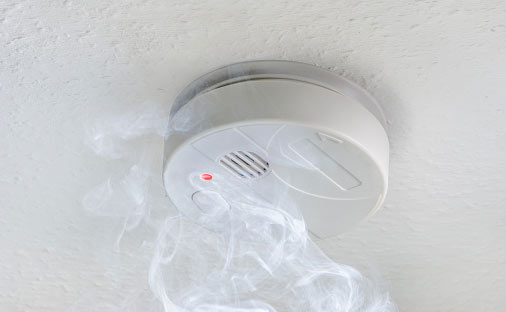Fire Prevention: Be Proactive!
Fire Prevention week
This week is Fire Prevention week, and the team here at Damar Security Systems cannot stress the importance of being prepared when it comes to Life Safety. We never like to hear from a new customer, that they have come to us, after an incident has occurred. Being proactive is the key to security, and that’s what this week is all about.
*Fire prevention was established to commemorate the great Chicago fire in 1871.
Potential vulnerabilities
We can all understand that during an emergency the ability to stay focussed can be a tough challenge. Taking preventative steps to be ready and prepared for such an emergency is vital.
This week is a great week to go through your home and review the potential vulnerabilities that could exist with regards to a house fire. Perhaps there are lamps place in vulnerable areas near curtains, or children’s blankets perhaps too close to outlets or night lights. Take a good look at your stove and kitchen set up, and even review your outdoor barbeque area to ensure these areas kept tidy, clutter.
According to reports by the National Fire Protection Agency (NFPA) Almost 2/3 of persons whose lives are lost in residential fires did not have a working smoke alarm in their home. Some additional hard to hear facts: most of these deaths happened within the months of December, January and February and were mostly related to home heating related issues and most of these causes were related to portable heaters too close to combustibles. Both the U.S. Fire Administration and the Canadian Fire Marshall’s Office backs this statistic and further adds that the peak time for these fires is between 6pm and 9pm and peaked in January and February. This information is culminated from fire department reporting systems across the United States and Canada. Overall, heating caused fires are second to cooking fires. Cooking fires are the highest cause and accounts for approximately 42% of residential fires annually.
And yet, another lesser known source is gas or electric clothes dryers. The buildup of lint is very combustible and can produce a concealed fire in the dryer or the exhaust line of a dryer. A clothes dryer works by pushing hot air past moist clothing that is turning in a large drum. As the clothes are spun in the drum, and heat passes by them, moisture and fiber particles exit the dryer through a lint filter and then out an exhaust line. A full load of clothes can contain as much as a gallon of water or more. The filter in a dryer attempts to collect the clothing fibers called lint, so you can remove them. This keeps the moist lint from clogging the exhaust tube which can block the exit of moist air and keep the dryer from drying the clothes efficiently. Although the lint filter does a good job, some lint does get past the filter and collects on the sides and bends of the dryer exhaust line and accumulates over time. Dryer vents should always be vented outside of your home. Never discharge dryer exhaust in to a living space or an attic. This moist air can lead to mold issues. Lint buildup is highly flammable. It is recommended that the exhaust pipe of a dryer be cleaned out or replaced annually or more often depending on your dryers use load. Foil or plastic exhaust pipes are the most troublesome due to the fact they can sag from the dryer heat and cause lint to build up at lower points in the line. Metal ducts made of either flexible or solid metal won’t sag and cause this problem with lint buildup like the flexible ducts do. Don’t forget to clean under the dryer and the back of it as well. Move combustibles such as papers and storage boxes at least three feet away from dryers and any heating appliances like furnaces and water heaters.
Emergency Home Escape Plan
As you go through your home, discuss and review potential escape routes and develop an Emergency Home Escape Plan that is effective and safe for everyone in your home to get out safely and quickly in the event of a fire. Access the windows, doors and what to do if a fire is outside your door are important things to review as well. Establish a meeting place outside of your home, so that everybody can be accounted for; in the event of having to evacuate your home quickly. Once again, we remind you that preparation is key. In the moments of an emergency panic can grab hold, and having a routine that is practised will make a big difference in the event of an emergency.
Monitored Smoke Alarm
Life safety is an important part of what we do at Damar Security Systems. Recognising the value of a monitored Smoke Alarm is important. Not only are you notified in the event of a fire through a siren and can initiate your emergency escape route, but you can also trust that help is on its way as well. The average cost of a single station type smoke detector at a home improvement center costs about $12.00 while a more advanced photo electric system type detector installed on a security system might cost about $85.00 – $100.00 installed in most homes. Either way it’s a small price to pay to save your life. The Ontario Building Code requires smoke detectors in all residential dwelling units. It is important to know and remember that these detectors are there for life safety. They are always powered by household electrical current – and thus will not work if the fire is of an electrical nature. They are not required to be monitored. This means if you are not home the fire will burn until a neighbour happens to notice smoke! By that time, it may be too late to save your home. Monitored smoke detectors have saved thousands of homes because of the combination of early detection and prompt response. Smoke detectors do save lives. We know – our systems have saved many lives over the years.

Protecting your home with monitored smoke alarms and with a strong home escape plan are all key ways to reduce the impact of fire related emergencies.
Remember, big fires always start small.


